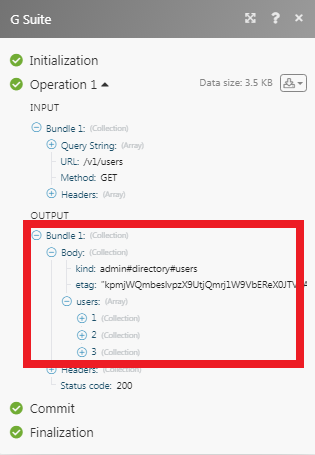G Suite Admin¶
Getting Started with G Suite Admin¶
The G Suite Admin modules allow you to watch, list, create, update, retrieve, and delete users, roles, role assignments, and organizational units in your G Suite Admin account.
Prerequisites
- A G Suite Admin account
In order to use G Suite Admin with Ibexa Connect, it is necessary to have a G Suite Admin account. If you do not have one, you can create a G Suite Admin account at https://gsuite.google.com.
Note
The module dialog fields that are displayed in bold (in the Ibexa Connect scenario, not in this documentation article) are mandatory!
Connecting G Suite Admin to Ibexa Connect¶
-
Go to Ibexa Connect and open G Suite Admin module's Create a connection dialog.
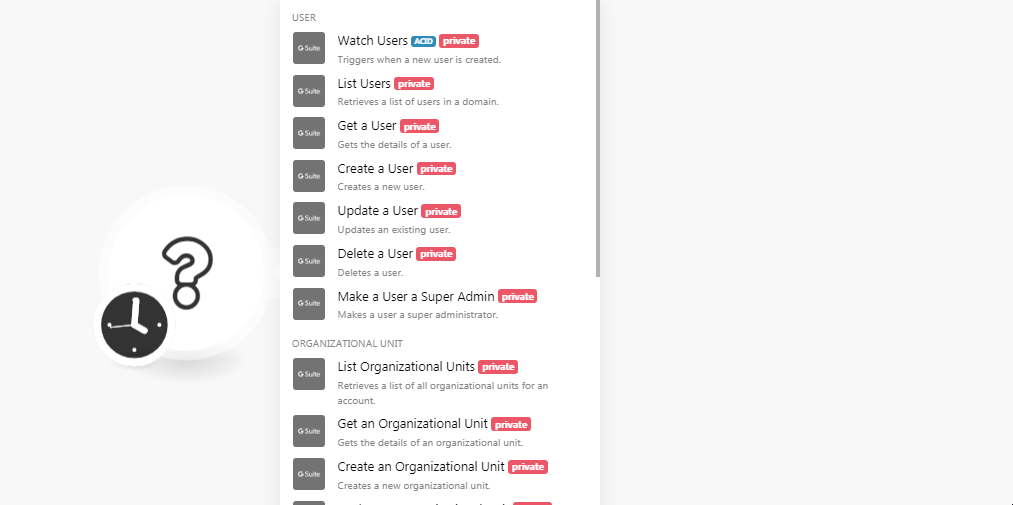
-
Click Continue.
-
Select the account with which you want to establish the connection.
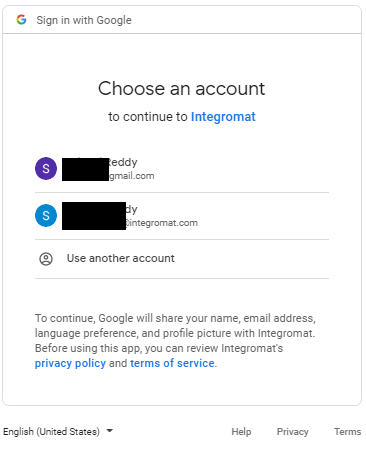
-
Confirm the account by clicking Allow.
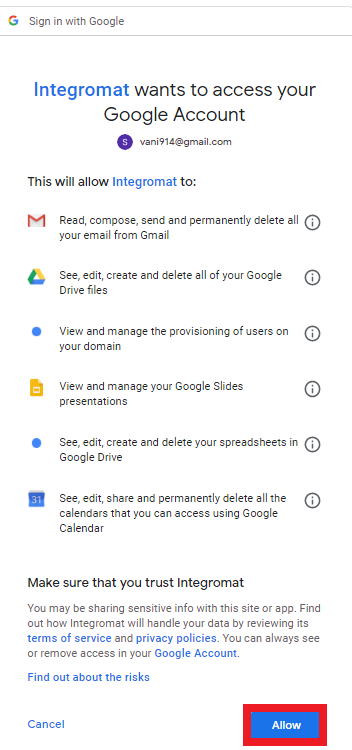
The connection has been established.
User¶
Watch Users¶
Triggers when a new user is created.
Your Domain |
Select the domain whose users you want to watch. |
Query Search |
Enter the search query. You can search the users with the following three attributes:
For more details, refer to the Search Query Documentation. |
Projection |
Select the subset to fetch the user details:
|
Custom Field Mask |
Enter a comma-separated list of schema names. |
Limit |
The maximum number of users Ibexa Connect should return during one scenario execution cycle. |
List Users¶
Retrieves a list of users in a domain.
Your Domain |
Select the domain whose users you want to list. |
Query Search |
Enter the search query. You can search the users with the following three attributes:
For more details, refer to the Search Query Documentation. |
Order By |
Select the order in which you want to list the users:
|
Projection |
Select the subset to fetch the user details:
|
Custom Field Mask |
Enter a comma-separated list of schema names. |
Show Deleted |
When selected, lists the users who are deleted. |
Sort Oder |
Select the order in which you list the users:
|
View Type |
Select the option to view the users:
|
Limit |
The maximum number of users Ibexa Connect should return during one scenario execution cycle. |
Get a User¶
Gets the details of a user.
User ID |
Select the User ID whose details you want to retrieve. |
Projection |
Select the subset to fetch the user details:
|
Custom Field Mask |
Enter a comma-separated list of schema names. |
View Type |
Select the view:
|
Create a User¶
Creates a new user.
First Name |
Enter the first name of the user. |
Last Name |
Enter the last name of the user. |
Password |
Enter the password of the user. |
Your Domain |
Select the domain for the user. |
Phones |
Add the phone numbers of the user: Phone Number Enter the phone number. Type Select the phone number type. Primary Select whether this is the primary phone number of the user:
|
Secondary Email |
Add the secondary email address: Email Address Enter the email address. Type Select the email address type:
|
Change Password at Next Login |
When selected, it prompts the user to change the password when tried to login next time. |
Update a User¶
Updates an existing user.
User ID |
Select the User ID you want to update. |
First Name |
Enter the first name of the user. |
Last Name |
Enter the last name of the user. |
Password |
Enter the password of the user. |
Your Domain |
Select the domain for the user. |
Phones |
Add the phone numbers of the user: Phone Number Enter the phone number. Type Select the phone number type. Primary Select whether this is the primary phone number of the user:
|
Secondary Email |
Add the secondary email address: Email Address Enter the email address. Type Select the email address type:
|
Delete a User¶
Deletes a user.
| User ID | Select the User ID of the user you want to delete. |
Make a User a Super Admin¶
Makes a user a super administrator.
| User ID | Select the User ID of the user whom you make a super admin. |
Organizational Unit¶
List Organizational Units¶
Retrieves a list of all organizational units for an account.
Path |
Select the path whose organizational units you want to list. |
Type |
Select the type of organizational units you want to list:
|
Limit |
The maximum number of organizational units Ibexa Connect should return during one scenario execution cycle. |
Get an Organizational Unit¶
Gets the details of an organizational unit.
Get Organizational Unit |
Select the method by which you want to retrieve the organizational units:
|
Organizational Unit Path |
Select the organizational path whose organizational unit details you want to retrieve. |
Create an Organizational Unit¶
Creates a new organizational unit.
| Name | Enter the name of the organizational unit. |
| Description | Enter the details of the organizational unit. |
| Parent Organizational Unit Path | Enter the path to the parent organizational unit if this organization is a subsidiary of any other organization. |
Update an Organizational Unit¶
Updates an existing organizational unit.
Get Organizational Path |
Select the method by which you want to retrieve the organizational units:
|
Organizational Unit Path |
Select the organizational path whose organizational unit details you want to update. |
Name |
Enter a new name for the organizational unit. |
Description |
Enter the details of the organizational unit. |
Delete an Organizational Unit¶
Deletes an organizational unit.
Get Organizational Path |
Select the method by which you want to retrieve the organizational units:
|
Organizational Unit Path |
Select the organizational path whose organizational unit details you want to delete. |
Role¶
List Roles¶
Retrieves a list of all roles in a domain.
| Limit | The maximum number of roles Ibexa Connect should return during one scenario execution cycle. |
Get a Role¶
Gets the details of a role.
| Role ID | Select the Role ID whose details you want to retrieve. |
Create a Role¶
Creates a new role.
Role Name |
Enter a name for the role. |
Role Privileges |
Add the permissions for the role: Service ID Select the service. Privilege Name Select the permission. |
Role Description |
Enter the details of the role. |
Update a Role¶
Updates an existing role.
Role ID |
Select the Role ID you want to update. |
Role Name |
Enter a name for the role. |
Role Privileges |
Add the permissions for the role: Service ID Select the service. Privilege Name Select the permission. |
Role Description |
Enter the details of the role. |
Delete a Role¶
Deletes a role.
| Role ID | Select the Role ID you want to delete. |
Role Assignment¶
List Role Assignments¶
Retrieves a list of all role assignments.
Search Role Assignments |
Select the option to search the role assignments you want to list:
|
Your Domain |
Select the domain whose role assignments you want to list. |
Limit |
The maximum number of role assignments Ibexa Connect should return during one scenario execution cycle. |
Get a Role Assignment¶
Gets the details of a role assignment.
| Role Assignment ID | Select the Role Assignment ID whose details you want to retrieve. |
Assign a User to a Role¶
Assigns a user to a specific role.
| Role ID | Select the Role ID which you want to assign to the user. |
| Assign To | Select the user to whom you want to assign the role. |
Delete a Role Assignment¶
Deletes a role assignment.
| Role Assignment ID | Select the Role Assignment ID you want to delete. |
Other¶
List Privileges¶
Retrieves a list of all privileges for a customer.
| Limit | The maximum number of privileges Ibexa Connect should return during one scenario execution cycle. |
Make an API Call¶
Performs an arbitrary authorized API call.
URL |
Enter a path relative to | For the list of available endpoints, refer to the G Suite Admin API Documentation: |
Method
Select the HTTP method you want to use:
GET
to retrieve information for an entry.
POST
to create a new entry.
PUT
to update/replace an existing entry.
PATCH
to make a partial entry update.
DELETE
to delete an entry.
Headers
Enter the desired request headers. You don't have to add authorization headers; we already did that for you.
Query String
Enter the request query string.
Body
Enter the body content for your API call.
Example of Use - List Users in a Domain¶
The following API call returns all the users in the same domain from your G Suite Admin account:
URL:
/admin/directory/v1/users
Method:
GET
Query String: Key: domain Value: {{domain you want to retrieve users from}}
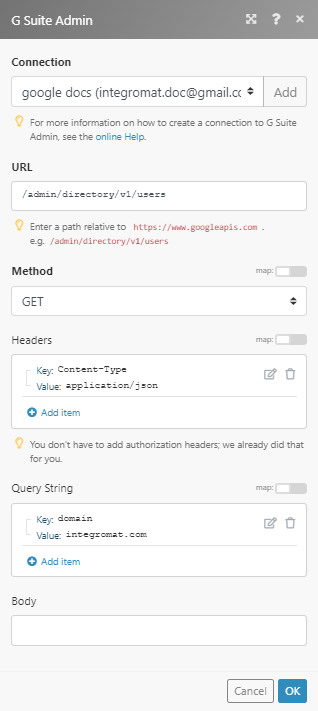
Matches of the search can be found in the module's Output under Bundle > Body > users. In our example, 3 users were returned:
